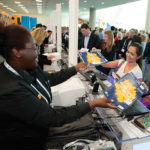1. U.S. Army in Europe
Designed by John Meyering, president of ARCHISPHERIX. Built by Capitol Tradeshow Services

DIMENSIONS
40 feet by 40 feet by 20 feet high
PURPOSE
The U.S. Army in Europe (USAREUR), which operates in 51 countries across Europe and into Asia, was looking for an exhibit to use at military-related trade shows in the United States. “The goal as I understood it was to find a way of presenting the U.S. Army presence [in Europe] in a way that was broad and sympathetic and sort of down to Earth,” Meyering said, “in a way that the public and even the military in the U.S. could comprehend what they were there for.”
FEATURES
Meyering’s approach was to create an inviting space that would present the Army “not so much as just a military force but rather as an integral part of the communities that they were serving.” He set six arches that curved gradually inward around the perimeter of the exhibit — with imagery of USAREUR soldiers on military maneuvers and interacting with local citizens adorning the outside of the arches, and the inside of each arch fitted with a stack of monitors that showed various USAREUR activities. At the center of the space was a circular, private meeting room of about 10 feet in diameter. Beyond a reception desk and a handful of tables and chairs, the exhibit was open and uncluttered. “People could move freely in and out and not feel pressured, but they could observe whatever they wanted,” Meyering said.
“They could read the screens, they could look at the imagery, they could step out, have a cup of coffee, come back later on, and not feel pressured.”
TRENDING
Flexibility USAREUR’s exhibit reflects a move toward booths that are flexible and adaptable. Meyering designed the space so that it fit comfortably into different size areas — shrinking down to 20 feet by 30 feet, say, or growing to 50 feet by 60 feet. And he made it so that USAREUR could easily update the design, which it did, using the space for three years in a row but each year switching out photos and tweaking the color scheme. “The design needs to be added to,” Meyering said, “without it looking as though the additional pieces were simply scabbed into the design.”
2. THE AGENDA SHOW
Designed and built by Global Experience Specialists (GES)

DIMENSIONS
41,000 to 87,300 square feet
PURPOSE
As the general services contractor for Reed Exhibitions’ Agenda show — a “lifestyle fashion trade show” that’s held twice a year each at the Sands Expo in Las Vegas, the Javits Center in New York City, and the Long Beach Convention & Entertainment Center — GES was tasked with designing the overall look of the expo as well as a variety of spaces on the show floor. Reed wanted to create a sort of hip streetscape, and “came to us with these shipping containers they wanted to use for the show,” said GES designer Robert Tu, “and that had kind of that urban vibe of just taking stuff and putting it together. And then they came up with the idea of using pallets and just the raw materials you would find every day out there on the street.”
FEATURES
Agenda’s show floor included public spaces such as a magazine stand, conversation nooks, and dining areas — all built with or bordered by the shipping pallets, and further tricked out with weathered oil drums, exposed light bulbs, and other design elements that matched the show’s street-chic aesthetic. “These pieces were just trying to resource what’s out there, just everyday items,” Tu said. “The wooden crates — the pallets — are just your typical 48-by-40[-inch pallets], so I took these pieces and put them into the computer, and it’s kind of like LEGOs. You start stacking the pieces and putting it together.”
TRENDING
Sustainability Reed needed a design that could be customized for each of Agenda’s three venues — ranging from 41,000 square feet at Javits, to 47,500 at the Sands Expo, to 87,300 in Long Beach — but was strong enough to establish a consistent brand. And it had to allow materials to be repurposed from one show to the next. “They came to us specifically because they knew that we had the resources to execute this nationwide,” said Lauren Radie, GES’s account manager for Agenda, “so they were able to have the consistent look but still use the pieces in different ways and maximize their investment and be cost-effective all around.”
3. MARTIN ENGINEERING
Designed and built by Nimlok

DIMENSIONS
20 feet by 45 feet by 16 feet high
PURPOSE
Martin Engineering, which offers a variety of products and systems in mining, materials, and other areas, needed a classic exhibit space — with a twist. The 20-foot-by-45-foot footprint had to encompass a two-level booth along with an open-layout show floor featuring product displays, but also had to be able to collapse down to a 10-foot-by-20-foot space, depending on how much room Martin books on a particular show floor. “I actually started out with a 10-by-20,” said Nimlok designer Jose Rodriguez. “Once we nailed down the 10-by-20, everything just started falling into place.”
FEATURES
The two-story structure includes a conference area on the top level and a traditional reception space tucked beneath that, where a video-game console was set up for people to hang out and play “Rock Band” — riffing on Martin’s product offerings in the area of rock separation. “Having the Rock Band video game set up inside,” Rodriguez said, “is just another way to bring potential clients in and then just kind of have people relax.” And the upper deck allowed Martin both to hold one-on-one meetings with clients and to keep tabs on the product floor. “If they’re waiting for a client,” Rodriguez said, “they can actually see down there and see them.”
TRENDING
Finish It’s not a coincidence that Nimlok covered up most of the Martin booth’s aluminum framework with cloth and laminate surfaces. “When I first started [three years ago], there was a lot of aluminum structure, which there still is today, but the aluminum structure was exposed,” Rodriguez said. “Now what I’m starting to see more and more is that clients are starting to pull away from the extrusion…. I think it’s a little too industrial for some people. They really miss that solid-wood construction.”
4. SONY ZONE
Designed by Momentum Worldwide. Built by Hargrove, Inc.

DIMENSIONS
33 feet by 50 feet by 40 feet high
PURPOSE
In the past, Sony took over several different areas at the Sony Open Tennis tournament in Miami, but for this year’s event, on March 17–30, the company decided to consolidate and elevate its presence — literally, with a double-decker, covered pavilion on the grounds of the Tennis Center at Crandon Park that offered 3,100 square feet of space. The idea was to use one dominant structure both to show off new products from Sony Mobile Communications as well as to entertain guests. “This year, we followed a ‘bigger, bolder, and better’ mantra that [Sony has],” said Jay Batavia, an account director at Momentum Worldwide, “where we wanted to not only create a visually prominent experience that engaged fans, but also business guests by integrating our hospitality lounge on top, which was something that used to be separate.” Added Kate Fee, a senior sales executive for Hargrove: “What we did for it this year, you really couldn’t miss it. There was no walking by this thing, that’s for sure.”
FEATURES
The first floor of the glowing white Sony Zone contained a fan-engagement zone, with displays of Sony smartphones, tablets, and televisions (fitted onto nine TV walls), a PlayStation 4 gaming area, autograph signings with tennis stars, and a phone-charging station where people could plug in their device in a secure locker and pick it up later. Upstairs was the hospitality suite, with an enclosed, air-conditioned area along with a patio overlooking the tennis courts — the entire level accessible via a staircase as well as a small elevator. “The pavilion really served a lot of different purposes,” Fee said. “And it turned out great.” Indeed, according to Batavia, traffic was up 40 percent from last year.
TRENDING
Engagement “If you’d go to a trade show, historically there were more sterile spaces,” Batavia said. “It was a lot of information, but it wasn’t positioned as an event that needed to engage a consumer. The thinking was, This is B-to-B, we’re buyers and sellers at a trade show. And now I feel when I go to a trade show or conference, a lot of the exhibitions are treating it like they’re at an event. They have to engage fans or consumers. They have to build something that’s more compelling.”
5. SIEMENS
Designed and built by Freeman

DIMENSIONS
80 feet by 80 feet
PURPOSE
At the AudiologyNOW! 2014 show, held at Orlando’s Orange County Convention Center on March 26–29, Siemens was introducing its new micron technology for a variety of electronic devices. “Siemens really wanted to make a statement in the marketplace,” said Nancy Ross, Freeman’s senior vice president of creative. “They wanted people to take note of them as a company. They really wanted to connect with the attendees. They wanted to know, how do we get attendees, for lack of the right word, to bond with our brand?”
FEATURES
Freeman’s solution was to design an open, inviting space with curving organic lines that mimicked the shape of the human ear, a soothing gray-and-aqua color scheme, and a variety of ways for Siemens staff and attendees to interact. “You could sit at a barstool and listen to sound quality on headphones,” Ross said. “You could watch a video while listening to sound quality on headphones. You could hear a staffer explain the attributes of these devices. You could go into a smaller room and dive even more deeply, or you could just kind of hang out in this space.”
TRENDING
Customization “Attendees want to have their experience in the space,” Ross said. “They want to have the experience that meets their needs, offers information, quenches their curiosity. They don’t want to just go and stand and receive, or be a recipient of a monologue. They want to explore and discover what they want to explore and discover.”



